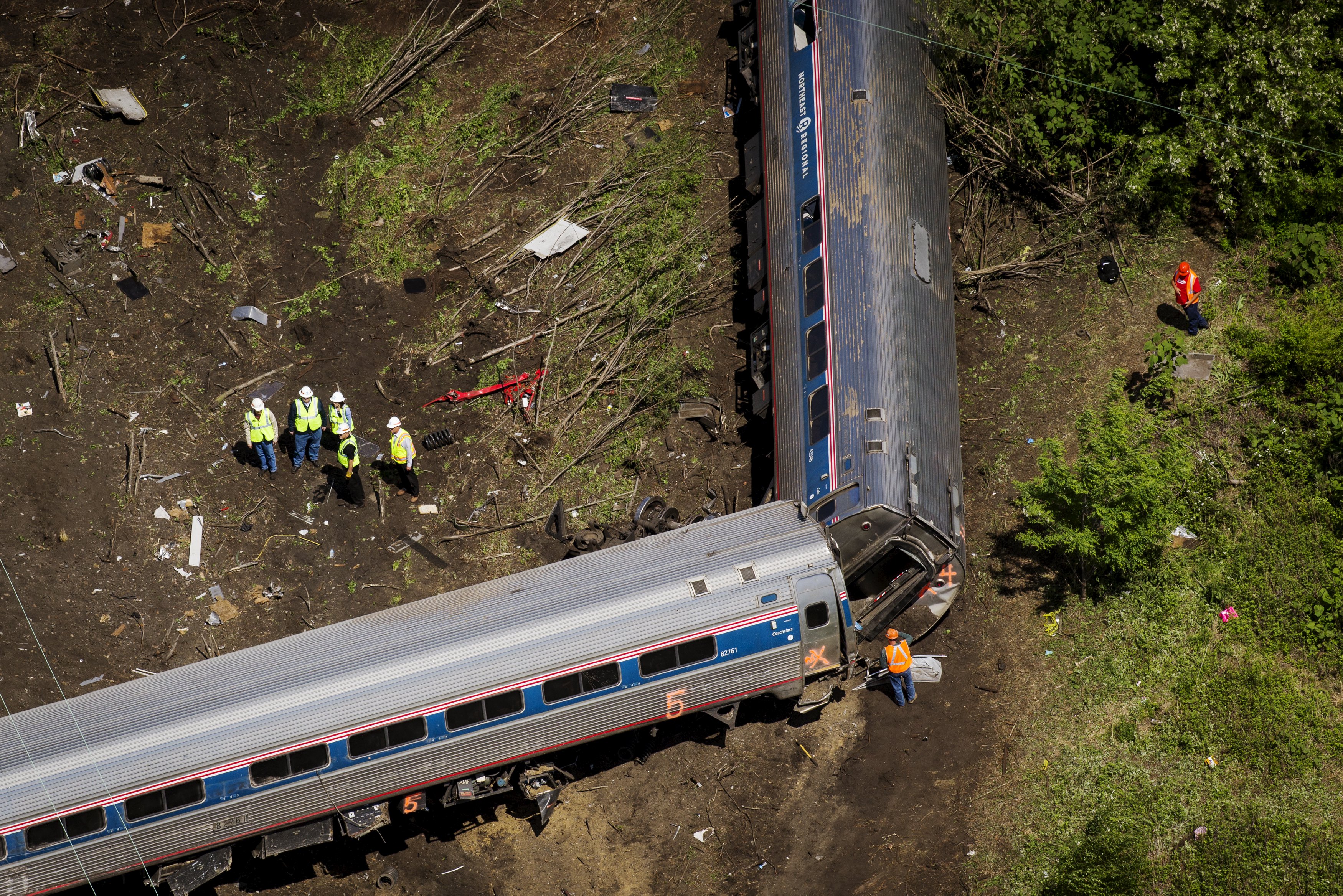An Amtrak train that derailed in Philadelphia, killing seven people, was barreling into a curved stretch of track at 100 miles per hour, over twice the speed limit, when the engineer slammed on the brakes, U.S. investigators said on Wednesday.
While the cause of Tuesday night's crash that injured more than 200 people remains to be determined, experts from the National Transportation Safety Board (NTSB) believe the derailment would have been prevented by installation of an advanced safety system called "positive train control," NTSB board member Robert Sumwalt said.
The engineer of the New York City-bound passenger train fully applied the locomotive's emergency braking system as it entered the left-hand curve in the rail line, where the maximum allowed speed is 50 miles per hour (80 km per hour), Sumwalt told a news conference hours after the NTSB began its probe.
But the brakes managed to only slightly slow the train from 106 mph (171 kph) to 102 mph in the few seconds before the locomotive and all seven passenger cars derailed, he said.
Asked how long it should take to slow a train moving that fast to the posted speed, Sumwalt said, "He was already in the curve at that point. You're supposed to enter the curve at 50 miles per hour."
Philadelphia Mayor Michael Nutter reacted with dismay to the disclosure, calling it "astounding, devastating."
"One-hundred, six miles per hour in a 50 mile-per-hour zone ... that's just insane," the mayor said.
Authorities have offered no explanation for why the No. 188 train, which originated in Washington, D.C., and had stopped in Philadelphia's 30th Street station about 20 minutes earlier, was traveling at more than double the authorized speed.
Sumwalt said NTSB investigators had not yet interviewed the engineer, who was injured in the wreck, but planned to do so in the next couple of days.
"This person has gone through a very traumatic event and we want to give him an opportunity to convalesce for a day or two," Sumwalt said. "But that is certainly a very high priority for us."
Nutter has said the engineer gave a statement to police, though police have declined to comment.
Sumwalt said data collected by the "black box" recorder recovered from the wreckage had yet to be fully analyzed, and investigators also planned to examine video footage from forward-facing cameras attached to the train.
He said the NTSB team expected to remain on the crash scene, in the Port Richmondsection of north Philadelphia along the Delaware River, for about a week.
In addition to speed, the NTSB has said it was focusing on the condition of the tracks and signaling equipment, crew training and the performance of the five-person crew.
Travel disruptions
Passenger rail service along Amtrak's Northeast Corridor, the country's busiest with 12 million passengers a year, was shut down immediately after the accident at about 9:30 p.m. EDT Tuesday (0130 GMT Wednesday), leaving travelers scrambling for alternatives. The derailment also snarled commuter rail services that share Amtrak tracks in the Philadelphia area and beyond.
A day after the accident, rescue workers were still pulling apart the twisted metal and sifting through other debris left by the crash. One of the rail cars landed upside down and three were tossed on their sides, while passengers and luggage were sent flying, survivors said, severely injuring some of them.
Authorities have not yet accounted for everyone believed to have been on board.
Hospitals in the area reported treating more than 200 people, city officials said. Amtrak has said 243 people, including a crew of five, were on board, authorities were still trying to confirm the number.
The crash seemed likely to heighten moves to expand installation of positive train control, or PTC, systems, designed to prevent high-speed derailments. No such system was in effect along the commuter rail line route where the Amtrak train left the tracks, officials said.
Positive train control automatically slows or even halts trains that are moving too fast or heading into a danger zone. Under current law, the rail industry must adopt the technology by year-end.
But the crash came a day before the House Appropriations Committee approved a transportation budget for the next fiscal year that included a funding cut for Amtrak.
One amendment proposed by Democrats called for $825 million in capital investments inPTC technologies for passenger rail, but it was blocked by the Republican majority.
Victims identified
One of the people killed was Midshipman Justin Zemser on leave from the U.S. Naval Academy in Annapolis, Maryland, an academy spokesman said.
An Associated Press video software architect was also among those killed. Jim Gaines, a 48-year-old father of two, had attended meetings in Washington and was returning to his home in Plainsboro, New Jersey, when the train derailed Tuesday night. His death was confirmed by his wife, Jacqueline.
A third victim was identified as Abid Gilani, a senior vice president at Wells Fargo & Co's commercial real estate division, the financial services company said in a statement.
The wreck was expected to renew concerns about the state of the aging U.S. rail infrastructure, but it also called into question the role of human factors in train accidents.
An NTSB investigation into the deadly Metro-North Railroad derailment that killed four people in the New York borough of the Bronx in 2014 found engineer William Rockefellerhad a serious sleep disorder known as sleep apnea.
A contributing factor in that high-speed crash, the NTSB said, was the railroad's failure to screen engineers for the problem and the failure of the Federal Railroad Administration to require such periodic testing.
Tuesday night's wreck occurred near the site of a 1943 rail accident that killed 79 people and injured 117 others, according to the National Railway Historical Society.























































